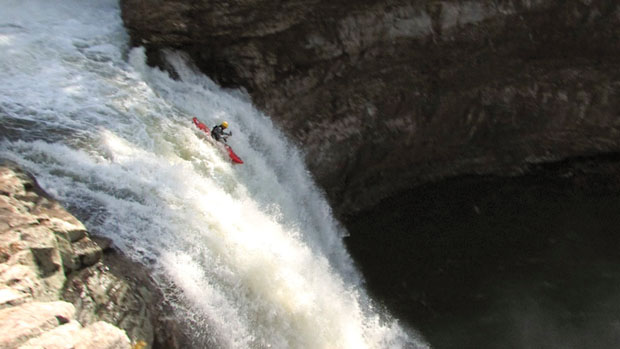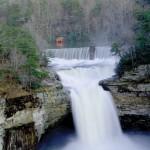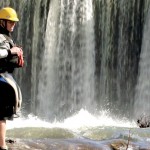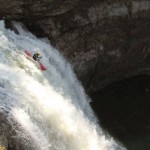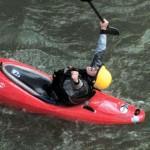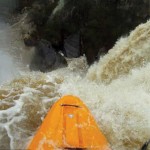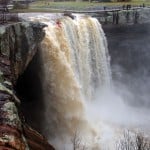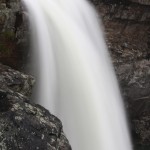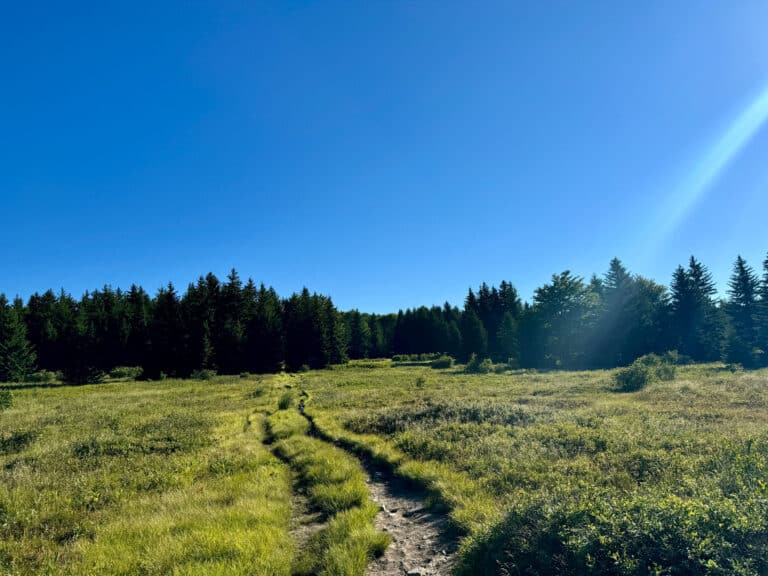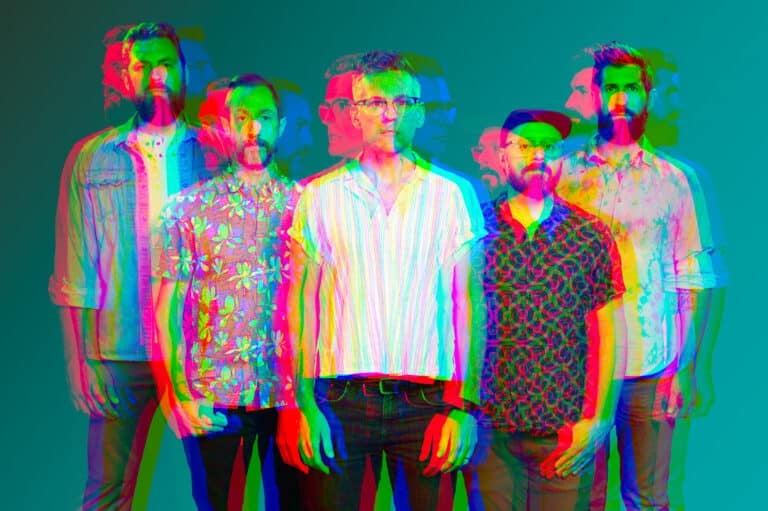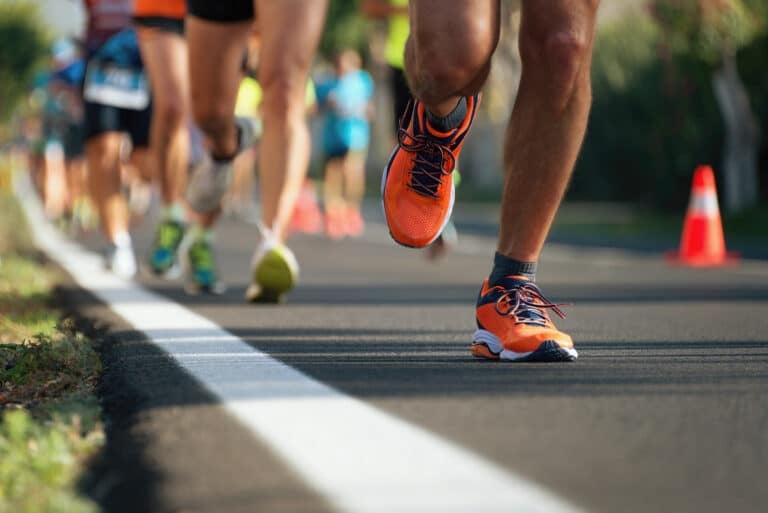Gragtmans on Desoto’s Edge. Photo: Chris Gallaway
As I sat in the college library distracting myself with a Google image search for “Alabama waterfalls,” I couldn’t believe my eyes. The photos depicted massive punchbowl amphitheatres, overhanging cliff walls, and deep emerald green plunge pools. What I was staring at seemed too good to be true. As my eyes scanned the postcard falls, I whispered to myself, “Those are runnable.“ I promptly set one of the images as my desktop background.
The Blue Ridge is a great place to be a kayaker. The scene is massive, so when contemplating a first D, one must ask oneself, “Many good kayakers have looked at this. Why haven’t they run it?” Apart from the technical difficulties and dangers of the Alabama waterfalls, the challenges also include a six hour drive and properly timing the water levels. During a 2005 recon scout of the area, Spencer Cooke and I looked at the first of these monsters, Desoto Falls. It was definitely one of the largest runnable waterfalls in eastern North America.
Three years later, a window opens. Several winter rainstorms have just bombarded the Southeast. I have been in conversation with Adam Goshorn, a long-time paddler in that area, and he confirms my suspicion that Desoto will be at a perfect level in the morning. A quick call to professional videographer Chris Gallaway, and the crew is in place for an attempt on the monster.
Desoto Falls
Sleep does not come easily when you are pondering falling 75 feet in the morning. A large waterfall is a funny thing: it represents the ultimate test of patience, finesse and water reading. It can also, however, mean the end of your kayaking career, since mistakes from that height can result in a broken back or worse. Balancing the possibility of an ultimate experience in the present moment with the desire to kayak for a lifetime requires wisdom and the humility to throw in the towel when it doesn’t feel right.
Chris and I are on the road before dawn. Six hours is a long time to think about whether something is a good idea or not, but the Appalachians paint a gorgeous picture as the winter sun rises and burns off the clouds from the receding storm cell. The roads and rivers along the way tell the same story: the rain has been falling, hard.
As we enter Desoto Falls State Park, I see the brown floodwater pouring over the dam and into the abyss. Shaking my head, I mumble, “This is actually happening right now.” As soon as the cars stop, we take off in a sprint to see what the river has in store.
The main drop is every bit as tall as I expected, and the entrance 20-footer presents an added challenge to the equation. Kayaking is very different from sports like climbing and biking. You cannot ride into a jump to get the feeling of it and stop at the lip. You cannot reach the crux of a climb and get lowered down to rest and go for attempt number two. In a kayak, you need to line it up in the correct place, take the correct strokes, react to the unexpected, and fully commit to what you are doing the first time. Hesitation makes a poor paddling partner.
After a long period of self-reflection, I reconcile myself with the risks involved in the first descent of Desoto Falls. Media and safety are in place, and the moment has come.
In times of apprehension on the river, I always find it helpful to ask for a guiding hand from my uncle, who taught me how to paddle and perished shortly thereafter following a battle with cancer. I then affirm to myself that I have worked hard to be where I am, and have made every possible preparation. That’s all you can really do, and at that point you take a deep breath and trust yourself.
My boat carves into the current, a powerful conveyor belt that propels me towards the largest waterfall of my career. An overhanging branch serves as my reference point for the narrow line. I allow my bow to dip as I crest the first waterfall, and, just as planned, a small ledge halfway down projects my boat out and past the hydraulic at the bottom. As I skip across the short pool and towards the abyss of the main waterfall, everything seems to slow down. I am relieved to be lined up properly, and my focus shifts to that last stroke as the steep ramp accelerates to freefall.
This stroke is the crucial moment of any large waterfall descent. It represents stability from side to side as well as a means to set your angle and pencil safely into the pool at the bottom. Too weak of a stroke, and you will pitch forward and over the bars, landing on your head off of 75 feet. Too powerful, and the kayak “boofs” out, resulting in a flat landing and a fractured spine. I place that stroke, and the canyon unfolds in front of me in a spectacular view.
The golden rule of any gravity sport is to always spot your landing. In this case, it scares me how far away my landing actually is. I lock my core, pull lightly on the stroke, and set my angle. I pick up speed at an alarming rate, but everything is silent. Gravity is an incredible sensation when experienced for that long, and as I fall I notice something that I’ve never experienced before: the solid sheet of water that started falling with me is now splitting apart and exploding into droplets and mist on all sides. I can hear and feel it transform, and it only adds to the otherworldly nature of the experience. As the pool rushes up to meet me, I quickly align my paddle parallel with my boat, and tuck my head in behind my elbow, making myself as streamlined as possible.
BOOM! The impact is a violent snap back to reality. I explode out of my tuck underwater, and am laid out on the back deck as the force of deceleration tries to rip my paddle from me. I lose one hand’s grip but hang on with the other. Darkness surrounds me, and I am being driven to the bottom of the river by the torrent above, but I manage to regain my hand on the paddle. Just as quickly as it started, I feel the current lessen its grip, and the inversely powerful force of buoyancy propels me upwards.
I burst to the surface upright, downstream, and to the left of the waterfall. Chris looks very small poised on the cliff above with his camera, and as my brain resets I am overcome with the most pure, gratifying feeling of accomplishment. The lip of the waterfall explodes in sunshine as if celebrating with me, and I can hear Adam hooting and hollering just downstream.
Accomplishing the first descent of Desoto was a peak experience of my kayaking career, and one that will always be remembered with pride and happiness. While it was excellent to relish in that accomplishment, the goal-setting personalities that we as kayakers have tend to keep our eyes faced forward.
Only 30 miles south of Desoto, another un-run Alabama monster was quietly awaiting any takers.
Noccalula Falls
The legend of this falls involves a Cherokee maiden, Princess Noccalula, who was in love with a brave from her own tribe, but was forced to wed another. Rather than enduring a life without love, she ended her life by casting herself into the waterfall that now bears her name.
With its deep heritage, high-profile location in the middle of downtown Gadsden, Ala., and massive proportions, Noccalula has long been grouped into the purely theoretical realm of Southeastern kayakers’ consciousness. Its giant arcing curtain extends at least another ten feet above that of Desoto, and to add to the challenges, Noccalula’s wide lip requires even more floodwater to make it a feasible proposition.
“Do you want to run a 90-footer tomorrow?”
The text appears on my phone from Isaac Levinson, and sends chills down my spine. I know exactly what he is talking about, and I too have been thinking that the storm that is soaking the region could bring Noccalula out of her slumber.
Before I have much time to think about it, I meet up with Pat Keller and John Grace, and we are driving from Asheville to rendezvous with Isaac and his safety crew at the falls. In stark contrast to my Desoto journey four years ago, our trip is riddled with hammering rainstorms and lightning flashes. I keep a steady stream of beat-driven music going to calm everyone’s nerves and buoy our confidence.
Drizzle, a deep roar, and rising mist greet us when we get out of the car. Upon reaching the overlook, we all have the same thought: “Holy sh-t, that thing is tall!” A wide, complicated lip makes the three foot wide line nearly impossible to make out from above, and even a perfect entry is subject to the uncertainties of 90 feet of freefall to drastically alter the boat’s angle.
After a great deal of deliberation, Pat and Isaac are ready, John is out, and I am very much on the fence. I have never had so much uncertainty about a waterfall. As my heart races, I alternate between telling myself, “I’m too old for this,” to “I know that I can stick that,” to “that is a career-ender with the slightest mistake.”
Ultimately I walk silently back to the cars and start putting on my gear. “I’ll make my decision at the lip” is what I tell Pat and Isaac, who are somberly checking every aspect of their gear. After a stretching and warm-up routine, the three of us emerge from our stealth staging location in full view of rangers, tourists, and the rest of the town. Pat walks confidently through the park and puts his kayak in the water. Onlookers are visibly disturbed, and begin calling 911. Our camera and safety crews are in place. It’s time.
As Pat cruises up to the lip, Isaac and I give away our nervous energy through a frenzy of narration. “Come on Pat, you’ve got this!” “You’re going to crush this!” “Nice, right over that curler.” “Now turn and burn, turn and burn!”
Pat lines the drop up perfectly and smoothly stabilizes his kayak to vertical for 65 feet of freefall before flicking his paddle out and away, and disappearing into the maelstrom. A few tense moments later, and he surfaces upright with two fists raised in victory.
“YEAHHH!”
After a few seconds of celebration, Isaac and I are running for our boats. Our cover is blown, and it’s only a matter of time before the police shut us down. Isaac is in his boat and in the current in no time. He has an identical perfect line and paddle toss, and I am once again floored by the hang time of the descent. Instead of appearing safely in his kayak, Isaac resurfaces swimming like a maniac away from the dangerous boulders on river right. Pat and fellow paddler Michael Montaigne pull him and his gear safely to shore.
“That’s okay, the drop is good,” I tell myself. “Just stick to your original plan.” I put a gallon or so of water in my boat to help my bow angle down to vertical, and all of a sudden I find myself in a brown flooding river above a massive horizon line. It’s as if my body has delivered me here involuntarily, and I am calmly watching from outside.
I line up the reference wave, turn at the lip, and do my best to keep my composure as I plummet downward at a speed of 9.8 meters/second squared. Freefall is an exponential dynamic, and it is scary how quickly you gain velocity. A 90-foot drop equates to 2.4 seconds in the air, and a landing speed of 52 miles per hour. About 50 feet down, I can feel that I am going over vertical. I take two quick paddle strokes and crunch my knees up to my chest to bring the boat back to the correct angle, ready for impact.
The landing of every waterfall manifests itself differently, but the pool at the bottom of Noccalula hits me more savagely than anything I have ever experienced. My paddle is instantly snapped across my chest and ripped from both hands. I see stars as my upper body explodes backwards and the waterfall tries to rip me in half. The impact and subsequent beating is so violent and disorienting that I hardly notice when I am somehow upright and clear of the mist. I look upstream and see the massive veil of water sheeting off of Noccalula. It looks even bigger from down here! I try to focus, but I am still seeing specks of light in a dizzy state of disconnection. I raise my arms in victory, but a searing pain in my chest makes me drop them. The oxygen has been crushed from my lungs, and I cannot speak or breathe. It’s a strange realization to know that you have just had a brush with your knockout threshold. Pat paddles over and asks how I’m doing. As my chest recovers, I smile silently at him and give him a big hug.
We did it.
While these two first descents occurred over the course of four years, they underscore an interesting and somewhat alarming trend in the sport of kayaking. The world record waterfall descent now stands at 186 feet, set by Tyler Bradt on Palouse Falls in Washington state. Although Tyler drew on years of experience in making that descent, many of the young up-and-comers are now running waterfalls over 70 feet in their first two years of paddling. There seems to be some level of complacency accompanying drops of that size, and this has brought with it a plethora of spinal fractures, knockouts, and other injuries. As with any young sport, the limits are being tested before our eyes, and who knows where it will go from here.
As for me, I’m not sure if I will run a waterfall taller than Noccalula. It’s an incredible feeling to push the limits of what is possible, but I also want to kayak indefinitely. There’s no doubt that the stakes are high with these large freefalls.
Then again, it would be cool to become a member of the triple digit club.
